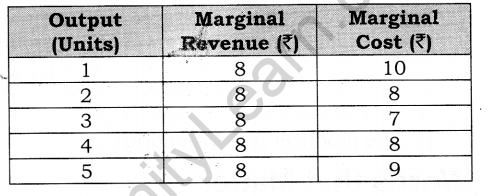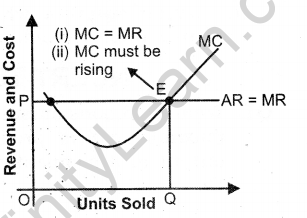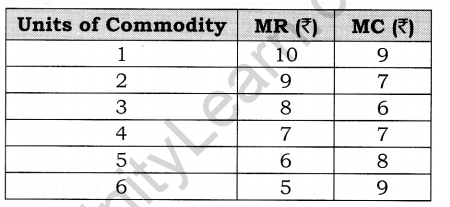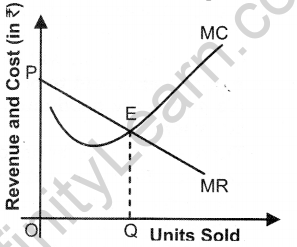Producer Equilibrium – CBSE Notes for Class 12 Micro Economics
Introduction
This chapter contains essentially the concept of producer equilibrium with marginal revenue and marginal cost approach, both when price is constant and when price is falling along with the numericals.
1. Profit refers to the excess of money receipts from the sale of goods and services (i.e, revenue) over the expenditure incurred on producing them (i.e, cost).
For example, if a firm sells goods for Rs. 5 crores after incurring an expenditure of Rs. 3 crores, then profit will be Rs. 2 crores.
2. A producer is said to be in equilibrium when he produces that level of output at which his profits are maximum. Producer’s equilibrium is also known as profit maximisation situation.
3. There are two methods for determination of Producer’s Equilibrium:
(a) Total Revenue and Total Cost Approach (TR – TC Approach)
(b) Marginal Revenue and Marginal Cost Approach (MR – MC Approach)
4. A firm produces and sells a certain amount of a good. The firm’s profit, denoted by π, is defined to be the difference between its total revenue (TR) and its total cost of production (TC). In other words, π= TR – TC

5. Producer’s equilibrium when price is constant with a rise in output under MR/MC approach is determined where,
(a) MR = MC (b) MC must be rising According to Table, both the conditions of equilibrium are satisfied at 4 units of output. MC is equal to MR and MC is rising. MC is more than MR when output is produced after 4 units of output. So, Producer’s Equilibrium will be achieved at 4 units of output.
However, MR is equal to MC at 2 units of output also.
But, second condition is not fulfilled here.
Let us understand the determination of equilibrium o with the help of a diagram.
Producer’s Equilibrium is determined at OQ level of «P output corresponding to point E as at this point, MC MR and MC curve cuts MR curve from below.

In Figure, output is shown on the horizontal axis and £ revenue and costs on the vertical axis. Producer’s Q Units Sold
equilibrium will be determined at OQ level of output corresponding to point E because at this, the following two conditions are met:
(a) MC = MR; (b) MC curve cuts the MR curve from below.
When MR > MC, then producer will continue to produce as long as MR becomes equal to MC. It is so because firm will find it profitable to raise the output level.
When MR < MC, then producer will cut down the production as long as MR becomes equal to MC. It is so because firm will find it Unprofitable to produce an extra unit. So, it starts reducing the level of output till MR = MC.
6. Producer’s equilibrium when price fall with a rise in output under MR/MC approach is determined where,
(a) MR = MC (b) MC must be rising When price falls with the rise in output, MR curve slope downwards. Let us understand this with the help of following table:

According to Table, both the conditions of equilibrium are satisfied at 4 units of output.
MC is equal to MR and MC is rising. MC is more than MR when output is produced
after 4 units of output. So, Producer’s Equilibrium will be achieved at 4 units of output.
Let us understand the determination of equilibrium ^ with the help of a diagram:

Producer’s Equilibrium is determined at OQ level of output corresponding to point E as at this point, MC = MR and MC curve cuts MR curve from below.
In Figure, output is shown on the horizontal axis and revenue and costs on the vertical axis. Producer’s equilibrium will be determined at OQ level of output g corresponding to point E because at this, the following two conditions are met: OQ Units Sold
(a) MC = M, and (b) MC curve cuts the MR curve from below.
When MR > MC, then producer will continue to produce as long as MR becomes equal to MC. It is so because firm will find it profitable to raise the output level.
When MR < MC, then producer will cut down the production as long as MR becomes equal to MC. It is so because firm will find it Unprofitable to produce an extra unit. So, it starts reducing the level of output till MR = MC.
So, the producer is at equilibrium at OQ units of output.
Words that Matter
1. Profit: Profit refers to the excess of revenue over cost.
2. Producer’s equilibrium: A producer is said to be in equilibrium when he produces that level of output at which his profits are maximum. Producer’s equilibrium is also known as profit maximisation situation.





